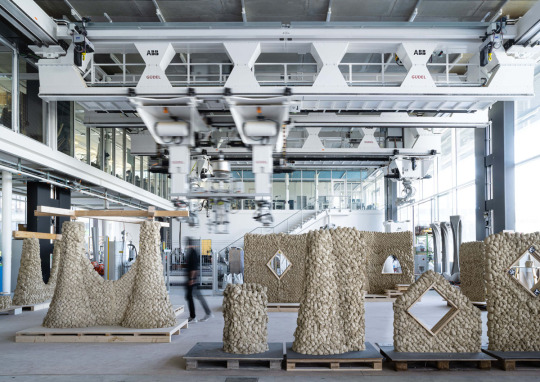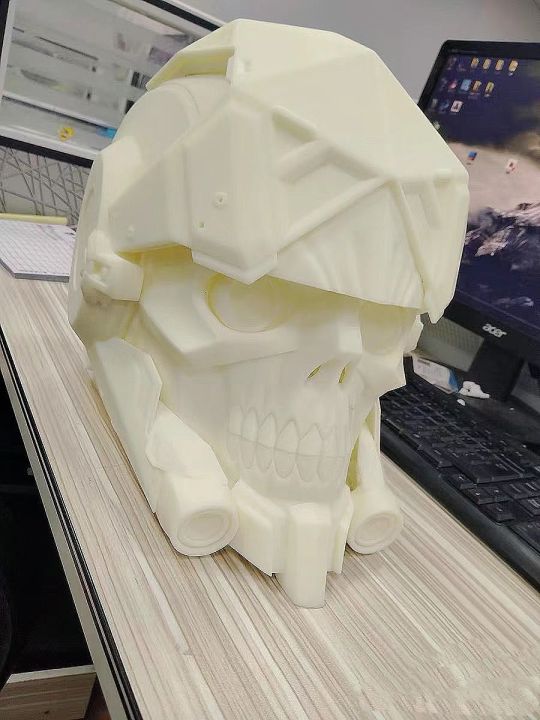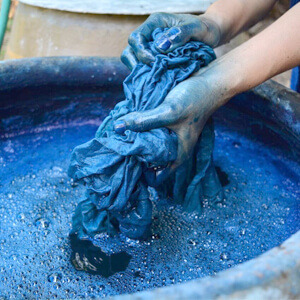#Innovative Printing
Explore tagged Tumblr posts
Text
Rapid Liquid Printing Market is in trends by enhancing supply chain resilience

Rapid liquid printing, also known as 3D printing with liquid materials, is an additive manufacturing technique that involves depositing liquid photopolymers layer by layer under a printhead to create 3D objects. The liquid photopolymer materials used in rapid liquid printing quickly solidify when exposed to light of a specific wavelength, allowing high-resolution parts and complex geometries to be produced. Rapid liquid printing offers several advantages such as the ability to produce intricate geometries and customized parts with greater precision. The technology allows limitless design possibilities and on-demand manufacturing, eliminating warehousing and shipping costs. It also minimizes material wastage and is more eco-friendly than traditional manufacturing processes.
The rapid liquid printing market is estimated to be valued at USD 60.7 Mn in 2024 and is expected to reach USD 251.5 Mn by 2031, growing at a compound annual growth rate (CAGR) of 22.5% from 2024 to 2031.
Key Takeaways
Key players operating in the Rapid Liquid Printing Market are 3D Systems, Inc., Stratasys , EnvisionTEC, ExOne , Rapid Liquid Print Company, EOS GmbH, Optomec, Inc., Dassault Systèmes, Materialise , Autodesk Inc., Carbon, Inc. , Asiga, Nexa3D , HP Development Company, L.P., Meltio3D. Major players are investing significantly in R&D to enhance process capabilities and develop new photopolymer materials with diverse properties.
The growing Rapid Liquid Printing Market Size for customized and personalized products across industries such as healthcare, automotive, consumer goods is a major factor driving the growth of the market. Rapid liquid printing allows low-volume manufacturing with mass personalization.
Global economic uncertainties have disrupted traditional supply chain models and heightened the need for distributed and on-demand manufacturing approaches such as rapid liquid printing, closer to the point of use. Customized parts can be 3D printed on-demand to enhance supply chain resilience.
Market key trends
Development of new photopolymers with improved properties is a key trend in the rapid liquid printing market. Existing materials have limitations in terms of chemical, mechanical, thermal properties and biocompatibility. New polymers are being developed to make liquid 3D printing suitable for high-volume production. Nanoparticle-enhanced photopolymers with superior strength and temperature resistance allow Rapid Liquid Printing Market Size and Trends to be used for functional prototypes and end-use parts.
Porter’s Analysis
Threat of new entrants: Low Start-up costs for new 3D printing technologies can threaten existing firms. However, established players have significant resources and customer base to withstand new competition.
Bargaining power of buyers: Moderate. Buyers have many options but are limited by stringent technical and regulatory standards required for medical and industrial applications.
Bargaining power of suppliers: Low. Suppliers of 3D printing materials and software have limited bargaining power due to availability of alternatives and integration between hardware and materials.
Threat of new substitutes: Moderate. Other additive manufacturing technologies like SLS and FDM provide substitutes but do not match resolution and versatility of liquid-based printing.
Competitive rivalry: High. Major players aggressively compete on price, technology and customer support leading to continuous innovation.
Geographical Regions
North America accounts for largest share of the liquid printing market currently, due to strong demand from medical, industrial and consumer sectors. Major research institutes in the US and availability of advanced infrastructure support growth in the region.
Asia Pacific is projected to grow at the fastest rate during the forecast period. Government support for additive manufacturing through funding and policy initiatives in China, India and other Asian countries is driving higher adoption of liquid printing technologies across industries. Emerging applications in consumer goods will further accelerate regional market expansion.
Get more insights on Rapid Liquid Printing Market
Discover the Report for More Insights, Tailored to Your Language
French
German
Italian
Russian
Japanese
Chinese
Korean
Portuguese
Alice Mutum is a seasoned senior content editor at Coherent Market Insights, leveraging extensive expertise gained from her previous role as a content writer. With seven years in content development, Alice masterfully employs SEO best practices and cutting-edge digital marketing strategies to craft high-ranking, impactful content. As an editor, she meticulously ensures flawless grammar and punctuation, precise data accuracy, and perfect alignment with audience needs in every research report. Alice's dedication to excellence and her strategic approach to content make her an invaluable asset in the world of market insights.
(LinkedIn: www.linkedin.com/in/alice-mutum-3b247b137 )
#Coherent Market Insights#Rapid Liquid Printing Market#Rapid Liquid Printing#3D Printing#Additive Manufacturing#Advanced Manufacturing#Liquid Printing#Rapid Prototyping#Industrial Design#Digital Fabrication#Innovative Printing
0 notes
Text
if you could pick the met gala theme what would you choose??
#i heard a rumor a while back that a theme would be athletic fasion innovation and i LOVED that idea#also a theme of textile printing#like. dif types of printing techniques/patterns/customs....#printing has been around for over 2k years there is SO MUCH.#anyways rb this i want to see what other ppl want#oh also maybe smth abt silhouette???
14K notes
·
View notes
Photo

Studio Oker / AutoStore / Innovation Hub / XYZ / Book / 2023
162 notes
·
View notes
Text

Swiss researchers develop robotic additive manufacturing method that uses earth-based materials—and not cement
Researchers at ETH Zurich, a university in Switzerland, have developed a new robotic additive manufacturing method to help make the construction industry more sustainable. Unlike concrete 3D printing, the process does not require cement.
According to a press statement from ETH Zurich, the robotic printing process, called impact printing, uses cheap, abundant, and low-carbon earth-based materials such as clay or excavated earth. Currently, the robotic additive manufacturing method uses a mix of excavated materials, silt, and clay. Most of the custom material is common waste product sourced locally from Eberhard Unternehmungen, a Swiss construction company. In the future, the process could use other materials.
With ETH Zurich’s method, a robot deposits material from above, gradually building a wall. On impact, the pieces of material bond together, with minimal additives. Whereas concrete 3D printing creates layers, ETH Zurich’s method extrudes and drops the material one bit at a time at velocities of up to 10 meters per second. The fast speed allows the material to bond quickly.
youtube
ETH Zurich’s process can build full-scale, freeform structures, including one- or two-story walls and columns. The printing tool has been used to build structures as tall as almost 10 feet. The process results in walls with a bumpy texture, but robotic surface finishing methods can achieve a smoother finish.
The custom printing tool can be integrated with multiple robotic platforms. As a result, the tool can build walls in both offsite facilities and onsite construction projects. At ETH Zurich’s Robotic Fabrication Laboratory, the tool has been integrated with a high-payload gantry system. The hardware can be mounted on an autonomous legged excavator to build walls on sites with variable terrain.
ETH Zurich says it aims to increase the cost competitiveness of sustainable building materials through efficient and automated production.
#solarpunk#solarpunk business#solarpunk business models#solar punk#solarpunk innovation#earth based construction#switzerland#3D printing#additive manufacturing#Youtube
34 notes
·
View notes
Text
Good News From Israel
Israel's Good News Newsletter to 2nd Jun 24
In the 2nd Jun 24 edition of Israel’s good news, the highlights include:
Israeli doctors saved the Arab girl critically injured in Iran’s attack on Israel.
An Israeli dedicated his Mount Everest climb to an Oct 7 victim.
Israeli medical tech is in touch with patients physically and virtually.
An Israeli device is the first to unblock veins to treat DVT.
A kibbutz startup devastated on Oct 7 is eradicating diseases at an Israeli hospital.
Israeli electric mopeds deliver the goods in Europe, the UAE & South Africa.
Israel topped the medals table at the Jiu-Jitsu European Championships.
Golden ring discovery makes a full-circle connection between Jews and Jerusalem.
Read More: Good News From Israel

Israelis might not have the wisdom of King Solomon, but some of their inventions, innovations, and achievements are extremely clever. Israeli electronic sensors can restore the sense of touch to damaged nerves. Doctors are 3D-printing prosthetics for amputees in Israeli hospitals. An Israeli smart catheter is the first device specifically designed to clear blocked veins. And Israeli long-distance tele-medicine is treating and caring for patients across Israel and in Africa. Smart sensors make Israeli beehives 50% more productive. An Israeli innovation improves the health of cows and the quality of their milk. Israeli paint prevents diseases. The roads are less polluted thanks to Israeli electric mopeds, and the free world is safer thanks to Israeli hi-tech defense systems. Plus much more. The photo is from a recent concert in Netanya by a popular band that very cleverly weaved together Israeli, Jewish and American folk music. Their name is appropriately, "The Solomon Brothers".
#3D-Printing#Arab#Artificial Intelligence#bees#cows#DVT#Everest#Gaza#good news#IDF#innovation#Israel#Jerusalem#Jewish#jiu-jitsu#Muslim#Papua New Guinea#plastic#robots#Tel Aviv
48 notes
·
View notes
Text
"Christien Meindertsma has developed a robot that can build 3D volumes out of wool. Known as the #FlocksWobot, it works in a similar way to a 3D printer to build up layers of wool. Instead of printing out layers of filament, it uses a form of felting." 👉 https://bit.ly/3sHJ5tB via Dezeen.
67 notes
·
View notes
Text
The only thing more annoying than people who are really into the Great Man theory of history are the people who swing so far in the other direction that they try to convince you that none of these historical figures actually accomplished ANYTHING and if you ascribe any significance whatsoever to them or their accomplishments it's because you're a credulous fool who's being brainwashed by Big History
#Gutenberg's printing press was actually super important. sorry guys.#with all technological advancements it's important to acknowledge that there were probably a bunch of other people working on the same thing#and also that they developed from previous technologies instead of springing fully-formed from someone's head like the birth of Athena#but to pretend that innovations that demonstrably led to HUGE cultural shifts#either didn't matter or weren't meaningfully distinct from the technology they evolved from#just. it drives me batty.
50 notes
·
View notes
Text

SEABIRD, SEABIRD, FLY HOME
three color 5x7 print for february patreon backers | shop
#linocut#linoprint#relief print#block print#block printing#printmaking#rainbow roll#this is an old block; i had a hell of a time printing it originally bc it was before i switched to oil inks#it was SOO much easier this time around. shocking#art tag#patreon tag#birds#bird art#sticker this month is the fire imp i drew ages ago. didn't wanna post it with this because i think it's nice by itself#this piece sponsored by the 1977 innovations cover of SEABIRD originally by the alessi brothers
140 notes
·
View notes
Text

𝑻𝒉𝒆 𝑻𝒊𝒔𝒔𝒖𝒆 𝑬𝒏𝒈𝒊𝒏𝒆𝒆𝒓𝒊𝒏𝒈 𝑴𝒂𝒓𝒌𝒆𝒕 𝒊𝒔 𝑩𝒐𝒐𝒎𝒊𝒏𝒈! 𝑨𝒓𝒆 𝒀𝒐𝒖 𝒊𝒏 𝒕𝒉𝒆 𝑲𝒏𝒐𝒘? 𝑺𝒆𝒄𝒖𝒓𝒆 𝒂 𝑭𝑹𝑬𝑬 𝑺𝒂𝒎𝒑𝒍𝒆: https://www.nextmsc.com/tissue-engineering-market/request-sample
The 𝑻𝒊𝒔𝒔𝒖𝒆 𝑬𝒏𝒈𝒊𝒏𝒆𝒆𝒓𝒊𝒏𝒈 𝑴𝒂𝒓𝒌𝒆𝒕 is expected to reach a staggering $17.97 billion by 2030, driven by advancements in biomaterials, stem cell research, and 3D printing technologies. This rapidly growing field holds immense potential to revolutionize healthcare by providing new solutions for: 𝑶𝒓𝒈𝒂𝒏 𝒕𝒓𝒂𝒏𝒔𝒑𝒍𝒂𝒏𝒕𝒂𝒕𝒊𝒐𝒏: Lab-grown organs could eliminate waitlists and revolutionize transplant procedures. 𝑹𝒆𝒈𝒆𝒏𝒆𝒓𝒂𝒕𝒊𝒗𝒆 𝒎𝒆𝒅𝒊𝒄𝒊𝒏𝒆: Engineered tissues could help patients heal from injuries and diseases more effectively. 𝑫𝒓𝒖𝒈 𝒅𝒊𝒔𝒄𝒐𝒗𝒆𝒓𝒚: Tissue models can be used to test new drugs and therapies more efficiently and ethically. 𝑲𝒆𝒚 ���𝒍𝒂𝒚𝒆𝒓𝒔: Organogenesis AbbVie Baxter International Inc. Terumo Medical Corporation Teijin Limited Straumann Group Integra LifeSciences Medtronic MiMedx 𝑨𝒄𝒄𝒆𝒔𝒔 𝑭𝒖𝒍𝒍 𝑹𝒆𝒑𝒐𝒓𝒕: https://www.nextmsc.com/report/tissue-engineering-market Are you a professional in the tissue engineering space? Join the conversation and share your expertise in the comments below!
7 notes
·
View notes
Text

#Kimoro Store#Design trends#Fashion designs#Creative t-shirts#Custom designs#Trendy fashion#Artistic designs#Modern apparel#Print on demand#Stylish clothing#Trendsetting designs#Graphic tees#Design innovation
3 notes
·
View notes
Text
"Generative AI and Global Politics: Shaping the Future of Innovation and Climate Action"

One of the most discussed topics today is Generative AI and its growing impact on businesses and society. This isn’t just a technological advancement but a transformation of how industries operate. Companies are increasingly using AI to drive productivity and innovation, reshaping workflows and decision-making processes. However, this trend brings ethical and regulatory challenges, with concerns about how AI might affect jobs, data privacy, and social equity becoming central to the conversation. (read more)
#ArtificialIntelligence#ClimateAction#SustainableFuture#Innovation#TechForGood#GlobalPolitics#COP28#DigitalTransformation#AIethics#ClimateChange#FutureOfWork#DataPrivacy#EmergingTech#EnvironmentalJustice#1950s#3d printing#70s#80s
3 notes
·
View notes
Text
Exploring the World of 3D Printing
Hey there, fellow tech enthusiasts! 👋
In today's blog post, we're diving headfirst into the fascinating world of 3D printing. If you're new to this technology or a seasoned pro, we've got something for everyone. Let's get started!

The Basics of 3D Printing If you're new to 3D printing, you're in for a treat. It's a revolutionary technology that allows you to turn digital designs into physical objects. We'll break down the basics, including how it works and the types of 3D printers available.
Applications Galore 3D printing isn't just for hobbyists; it's changing industries from healthcare to aerospace. Discover the incredible real-world applications of 3D printing, from custom prosthetics to space-ready components.
Choosing the Right Filament One of the key decisions in 3D printing is selecting the right filament material. We'll discuss the various options like PLA, ABS, and PETG and guide you in choosing the perfect material for your projects.
Designing for 3D Printing Ready to create your own 3D models? We'll introduce you to 3D design software and provide tips for designing models that print flawlessly. Plus, we'll share some fantastic resources for free 3D models to kickstart your creativity.
Troubleshooting and Maintenance Like any tech, 3D printers can have their quirks. We'll go over common issues you might encounter and how to troubleshoot them. Maintenance tips to keep your printer in top shape will also be on the menu.
Inspiration and Community Be inspired by jaw-dropping 3D printing projects and join the vibrant online 3D printing community. Share your creations, learn from others, and be part of the maker movement.
Don't miss out on the 3D printing revolution! Stay tuned for more exciting content as we explore this innovative world. Follow us for updates, and feel free to reach out with your questions and ideas. Happy printing, folks! 🔧🖨️🌟
11 notes
·
View notes
Text
RIP Stefania Zahorska you would have loved glossy high-resolution full-color images incorporated into printed books
#She talks about innovations in color printing as this tremendous thing#Where you don't have to take students to museums to teach them about color theory#Especially if they live in rural areas they can really look at art and design#And I was like#Once again if I could give Stef anything to read while she was still alive#In the interwar period#It would be The Work of Art in the Age of Mechanical Reproduction#stefania tag
5 notes
·
View notes
Text

Medarrch is an Italian design company using eco-materials and new technologies to create sustainable, innovative furniture with high style
A solarpunk architecture and design firm. Medarrch, creates products where digital technologies mix with a humanistic approach to design, using bioplastics to create the most stunning 3-D printed furniture. Founder designer and innovator Amleto Picerno
Eco-materials and sustainable design
During the pandemic, they began working on a new product line named Mediterranea, which uses 3D-printed PLA material to make furniture for inside and outside use. PLA is an innovative bioplastic sourced from sugars found in corn, renewable and non-petroleum-derived materials. All products are made from 100 percent recyclable materials. So, besides being stylish and modern, their furniture is also biodegradable and compostable.

“It’s a circular economy way to think. Also a new kind of company. And we are in, how to say, a historical moment where innovation is only innovative if it’s sustainable; otherwise, it’s not innovation for us,” added Ceraso
#solarpunk#solarpunk business#solarpunk business models#solar punk#reculture#italy#design#3D printing#solarpunk innovation#biodegradable and compostable furniture#design and innovation
13 notes
·
View notes
Text





𝐃𝐢𝐬𝐜𝐨𝐯𝐞𝐫 𝐭𝐡𝐞 𝐀𝐫𝐭 𝐨𝐟 𝐅𝐚𝐛𝐫𝐢𝐜 𝐃𝐲𝐞𝐢𝐧𝐠: 𝐓𝐞𝐜𝐡𝐧𝐢𝐪𝐮𝐞𝐬 𝐓𝐡𝐚𝐭 𝐓𝐫𝐚𝐧𝐬𝐟𝐨𝐫𝐦 𝐓𝐞𝐱𝐭𝐢𝐥𝐞𝐬
Delve into the world of fabric dyeing and printing with our comprehensive guide. Explore traditional techniques like batik and tie-dye, and discover modern methods such as digital printing. Learn how artisans achieve vibrant colors and intricate patterns, and find the best approach for your textile projects.
Regards, Fashion Articles by Waves Fashion Institute
#fashion dyeing#fabric printing#batik#screen printing#block printing#natural dyes#dyeing techniques#printing methods#textile art#textile innovation#fabric art#textile design
1 note
·
View note
Text
Exploring the 3D Printing World with QIDI Tech: Is PLA Filament Toxic?
Hello everyone! Today, I want to dive into the exciting world of 3D printing, specifically focusing on the reputable brand QIDI Tech and the commonly used PLA filament.
As many of you may know, 3D printing has revolutionized the way we create and manufacture objects. It's a fascinating technology that allows for endless creativity and innovation. QIDI Tech stands out in this industry for its high-quality printers and user-friendly experience, making it a great choice for both beginners and experienced users alike.
Now, let's address a common concern: Is PLA filament for 3D printing toxic? The good news is that PLA, or Polylactic Acid, is derived from renewable resources like corn starch or sugarcane, making it a biodegradable and environmentally friendly option. Unlike some other materials, PLA emits very few fumes when heated, which makes it a safer choice for indoor printing. Many users appreciate this aspect, as it allows for a more pleasant printing experience without the worry of harmful emissions.
In conclusion, with QIDI Tech's excellent printers and the safe, eco-friendly nature of PLA filament, 3D printing can be a rewarding and enjoyable hobby. So, let's get creative and explore all the possibilities this amazing technology has to offer!
0 notes